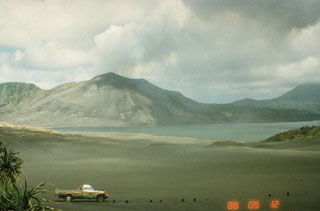Report on Yasur (Vanuatu) — April 2000
Bulletin of the Global Volcanism Network, vol. 25, no. 4 (April 2000)
Managing Editor: Richard Wunderman.
Yasur (Vanuatu) Typical explosive activity observed in February
Please cite this report as:
Global Volcanism Program, 2000. Report on Yasur (Vanuatu) (Wunderman, R., ed.). Bulletin of the Global Volcanism Network, 25:4. Smithsonian Institution. https://doi.org/10.5479/si.GVP.BGVN200004-257100
Yasur
Vanuatu
19.532°S, 169.447°E; summit elev. 361 m
All times are local (unless otherwise noted)
Yasur volcano was visited during 18-20 February by John Seach, Geoff Mackley, and a film crew from the United Kingdom. There was a lower level of activity than in June and July 1999 (BGVN 24:07). "Level 1" activity predominated, defined as normal activity where bombs generally fall within the cone area. The three main craters within the cone, A, B, and C, are aligned S to N.
On 18 February Crater A silently emitted small amounts of white vapor tinged with blue. The following day observers saw emission of brown ash but again heard no noise from the crater. Crater B was also silent and only emitted a small amount of white vapor. Two smaller craters E of Craters A and B were continually full of vapor. Crater C exhibited the main activity. There were two active vents at the N and S ends of the crater. The inside crater wall was strongly fumarolic. Over a 2-hour period Crater C produced four explosions from the N vent and three from the S vent. Incandescent bombs were thrown to a height of 120 m. Some bombs glowed for 30 minutes after dark.
On 19 February observers lowered themselves 50 m to the floor of the Yasur cone from the SE using ropes. Ground temperature 15 m S of Crater C was 96°C. The floor was littered with black bombs up to 1.5 m in diameter and covered with ash. Explosions threw lava to a height of 250 m. Bombs were either thrown straight up or directed towards the NW edge of the cone. Explosions occurred ten times per hour and were accompanied by ground shaking and sometimes shockwaves. Degassing was heard every few seconds between explosions. Inside the cone a number of earthquakes were felt which were not accompanied by explosions or degassing; these earthquakes were not felt by observers on the crater rim, 100 m away. Inside the cone there was a strong sulfur smell and fumes irritated eyes.
On 20 February activity increased. Incandescent lava was ejected every few seconds. Larger explosions about 8 times per hour sent lava to 300 m elevation and 100 m away from the vent. The active vents glowed orange after dark.
The NW flanks of Yasur cone down to Lake Siwi were littered with large bombs from the 1999 activity. Black bombs to 3 m in diameter were observed at the base of the cone. Approaching Yasur remains dangerous at any time for visitors. Vehicles can be driven to within 20 m of the cone and this encourages tourists to visit the crater edge. Unpredictable trajectories of bombs and variable eruptive activity pose threats to visitors. It should be noted that three deaths occurred on Yasur in 1994-95 during a period of low activity (BGVN 20:08).
Geological Summary. Yasur has exhibited essentially continuous Strombolian and Vulcanian activity at least since Captain Cook observed ash eruptions in 1774. This style of activity may have continued for the past 800 years. Located at the SE tip of Tanna Island in Vanuatu, this pyroclastic cone has a nearly circular, 400-m-wide summit crater. The active cone is largely contained within the small Yenkahe caldera, and is the youngest of a group of Holocene volcanic centers constructed over the down-dropped NE flank of the Pleistocene Tukosmeru volcano. The Yenkahe horst is located within the Siwi ring fracture, a 4-km-wide open feature associated with eruption of the andesitic Siwi pyroclastic sequence. Active tectonism along the Yenkahe horst accompanying eruptions has raised Port Resolution harbor more than 20 m during the past century.
Information Contacts: John Seach, PO Box 16, Chatsworth Island, N.S.W. 2469, Australia.

